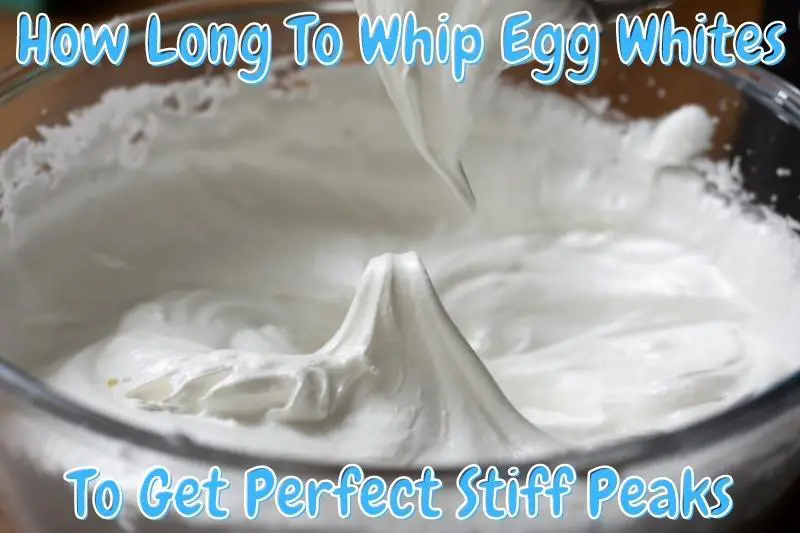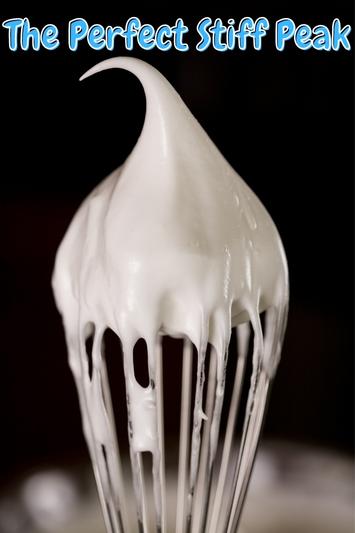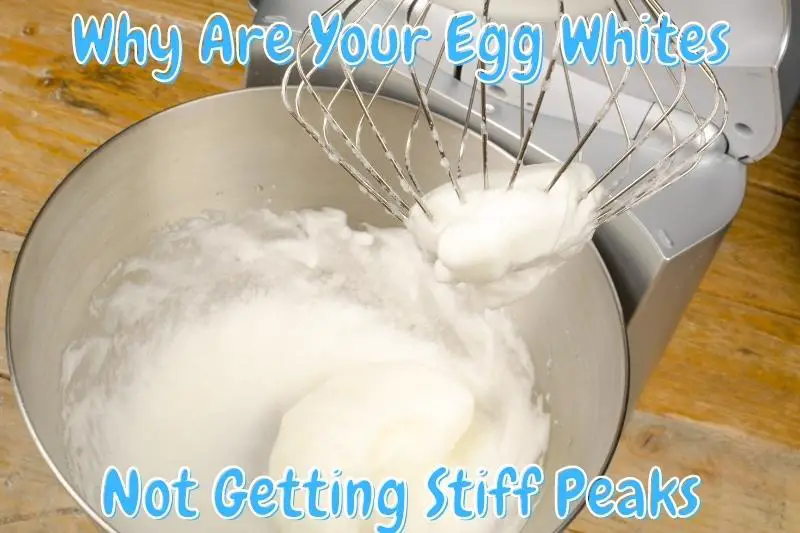This post contains affiliate links.
Have you ever made a recipe that called for stiff peaks and wasn’t sure how long to whip the egg whites? Don’t worry, you are not alone. Many people don’t know how to get those beautiful, stiff peaks that make desserts look so impressive. So how long should you whip egg whites to get stiff peaks?
Generally speaking, you should get stiff peaks after around 4-5 minutes depending on your speed of whipping. If you are using an electric mixer, start at a lower speed and gradually increase the speed as the egg whites become foamy. However, if you’re hand-whipping, it will take a little longer.
Below, I explain in more detail how to get stiff peaks and the different factors that can affect your results.
How Long Should You Whip Egg Whites To Get Stiff Peaks?
How long you should whip your egg whites to get stiff peaks depends on a few different factors. The temperature of your egg whites and the speed at which you whip all play a role in how long it will take to get stiff peaks.
Note that stiff peaks are achieved more easily when the egg whites are free from any yolk. So the separation part is as important as the whipping part.

While I like to do my mixing by hand, I much rather prefer using a Stand Mixer instead. I recently wrote an article that talks about the 3 Best Stand Mixers that bakers can buy in each stage of their baking journey. After reviewing a few stand mixers, the Best Overall Mixer was the KitchenAid Artisan Tilt-Head Stand Mixer. You can check out this stand mixer on Amazon!
I have noticed that the whites separate perfectly when the eggs are cold. So you want to make sure your eggs are cold before you start whipping.
However, you will achieve stiff peaks faster when the whites are a little warm. Therefore, you might want to set the bowl of egg whites in a warm water bath for a few minutes before you start whipping.
This will make it easier to achieve stiff peaks and will also help the whites to hold their shape better when baked.

How long should you whip your egg whites to get perfect stiff peaks:
| Using a Fork | Using a Whisk | Using an Electric Mixer |
| 4-5 minutes | 3-5 minutes | 2-3 minutes |
If you are using an electric mixer, you should start at a lower or medium speed and gradually increase the speed as the egg whites become foamy. After about 3 minutes of whipping on medium speed, you should have soft peaks forming.
Soft peaks are when the whites are starting to hold their shape but are still droopy.
Continue whipping at a higher speed until you reach stiff peaks. Stiff peaks are when the whites stand up straight and have a glossy sheen to them. You should be able to hold your mixer upside down without the whites falling out.
Why Are My Egg Whites Not Getting Stiff?
The most common reason for egg whites not getting stiff is that there is something in the bowl that is preventing them from foaming. This could be a drop of water, grease, or a speck of egg yolk. Make sure your bowl and whisk are completely clean and dry before you start whipping the egg whites.
Any grease or water will prevent the whites from getting stiff.
If you are using an electric mixer, another reason your egg whites might not be getting stiff is that the speed is too low. When the speed is too low, the whites won’t have enough air incorporated and will deflate.

*By the way, I wouldn’t be able to fix my runny buttercream frosting if I didn’t have the right type of mixer. For this situation, I used a 5-Speed Electric Hand Mixer which can get the job done! You can check out the Hand Mixer I use on Amazon!
Another reason could be that you haven’t whipped for long enough. I have found that it usually takes me about five minutes to get soft peaks and ten minutes to get stiff peaks.
The temperature of your egg whites can also affect how well they whip up. If the egg whites are too cold, they might not get as stiff. So, you might want to warm them up a bit before you start whipping.
Lastly, make sure you are using fresh eggs. Older eggs are more likely to have watery whites that don’t whip up as well.
How Do You Whip The Perfect Egg White?
To whip the perfect egg white, start by making sure your bowl and whisk are clean and dry. Separate the egg whites from the yolks when the egg is still cold while making sure not to break the yolk. Transfer the egg whites to a bigger mixing bowl and start whipping them at medium speed.
Egg whites have different stages, or peaks when you’re whipping them. Depending on the dessert you are making, some require soft peaks while others require stiff peaks.
The difference between peak consistency is the amount of time you whip the egg whites. The longer you whip, the stiffer and thicker the egg whites become.
“Stiff peaks (not only does the peak on the egg white surface hold but so will the peak on the whisk or beaters when turned to peak upwards as shown above).”
thespruceeats
Now set the mixer to a medium speed and start whipping. Slowly increase the speed as the whites start to foam.
You can add cream of tartar at this point to help the whites stiffen. After about five minutes, you should have soft peaks.
Continue whipping at a higher speed until you reach stiff peaks. You will know you have reached stiff peaks when the whites are glossy and stand up straight.
*By the way, I recently wrote an in-depth article about The Differences Between Whisking and Whipping. This article talks about how and when to use the whisking and whipping methods. You can check out this article here!
What Happens If Stiff Peaks Won’t Form?
If the stiff peaks don’t form after 5-10 minutes, continue whipping the egg whites for a few more minutes. If the whites still won’t stiffen, you can add a little cream of tartar or vinegar to help them along. The acidity in these ingredients helps stabilize the egg whites making them become stiff.
If your egg whites are still not getting stiff, there might be something in the bowl preventing them from foaming.
Make sure your bowl and whisk are clean and dry.
Even though it might be a hassle, you can also try using a different bowl and start over with new egg whites. This is the option for you only if you really don’t know which of the above reasons is causing your egg whites not to form stiff peaks.
*By the way, I recently wrote an article about The Differences Between Whipping and Beating. This article talks about how and when to use the whipping and beating mixing methods. You can check out this article here!
How to Whisk Egg White till Stiff with a Fork?
To whisk egg whites until stiff with a fork, you’ll need to tilt the bowl at an angle with your non-dominant hand and create circle-like patterns with the fork using the motion of the wrist of your dominant hand. This allows the air to pass through the holes on the fork creating foamy egg whites.
It will take you longer, but the procedure is still the same. Separate the egg white from the yolk and make sure there is no yolk in the whites. Add cream of tartar if desired.
Start whisking at a lower speed and gradually increase as the peaks start to foam. After about ten minutes, you should have stiff peaks.
Here’s a video I found showing exactly how fast it takes to get stiff peaks with a fork:
You can do this by either using an OXO Good Grips 11-Inch Balloon Whisk or by using a KitchenAid K45WW Wire Whisk Attachment for Tilt-Head Stand Mixer depending on whether you have a KitchenAid mixer or not. Either way you choose to whisk, you can check out both of these tools on Amazon!
If you are whisking by hand, it will take a little longer since you won’t have the same power as an electric mixer. It is still possible to achieve stiff peaks, but it will require some elbow grease.
Start whisking at a lower speed and gradually increase the speed as the egg whites become foamy.
After about ten minutes of whisking, you should have stiff peaks. If your arm starts to get tired, take a break for a few minutes before continuing.
Can You Overbeat Egg Whites?
Generally speaking, it’s possible to overbeat egg whites. You’ll know they are overbeaten when the form falls, becomes grainy, and turns watery. You cannot salvage overbeaten egg whites, so it’s best to start over if this happens. Overbeaten egg whites will also deflate and lose its stiffness.
Egg whites have a certain splitting point where they are overbeaten which breaks up the composition of your whipped egg whites.
This is when the egg whites release water, causing the form to fall and become grainy.
They are very hard to salvage but sometimes adding some acid like cream of tartar might help absorb the excess moisture.
*Side Note: I recently wrote an article about The Differences Between Whisking and Beating. This article talks about when you are supposed to use each of these mixing methods. You can check out this article here!
What to Do With Over-Beaten Egg White?
Once your egg whites are overbeaten, you can try adding ingredients that contain acidic properties such as cream of tartar. This might help salvage the overbeaten egg whites since the acidity should absorb and stabilize the excess moisture making them stiff once more.
You can also try adding other egg whites to it and whisking the mixture again. This might help to salvage the egg whites if there were not a lot in the mixture, to begin with.
However, if that doesn’t fix the overbeaten egg whites, it is better for you to start over with new egg whites.
However, adding new egg whites to overbeaten ones will likely mess up the new ones as well, so it’s best to avoid this if possible.
*By the way, I recently wrote an article about All The Different Mixing Methods in Baking. This article talks about the 10 different mixing ways you can use when making your baked goods. You can check out this article here!

